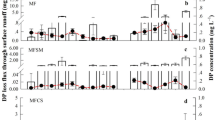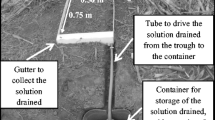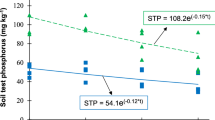Abstract
Losses of phosphorus (P) from soil and slurry during episodic rainfall events can contribute to eutrophication of surface water. However, chemical amendments have the potential to decrease P and suspended solids (SS) losses from land application of slurry. Current legislation attempts to avoid losses to a water body by prohibiting slurry spreading when heavy rainfall is forecast within 48 h. Therefore, in some climatic regions, slurry spreading opportunities may be limited. The current study examined the impact of three time intervals (TIs; 12, 24 and 48 h) between pig slurry application and simulated rainfall with an intensity of 11.0 ± 0.59 mm h−1. Intact grassed soil samples, 1 m long, 0.225 m wide and 0.05 m deep, were placed in runoff boxes and pig slurry or amended pig slurry was applied to the soil surface. The amendments examined were: (1) commercial-grade liquid alum (8 % Al2O3) applied at a rate of 0.88:1 [Al/ total phosphorus (TP)], (2) commercial-grade liquid ferric chloride (38 % FeCl3) applied at a rate of 0.89:1 [Fe/TP] and (3) commercial-grade liquid poly-aluminium chloride (10 % Al2O3) applied at a rate of 0.72:1 [Al/TP]. Results showed that an increased TI between slurry application and rainfall led to decreased P and SS losses in runoff, confirming that the prohibition of land-spreading slurry if heavy rain is forecast in the next 48 h is justified. Averaged over the three TIs, the addition of amendment reduced all types of P losses to concentrations significantly different (p < 0.05) to those from unamended slurry, with no significant difference between treatments. Losses from amended slurry with a TI of 12 h were less than from unamended slurry with a TI of 48 h, indicating that chemical amendment of slurry may be more effective at ameliorating P loss in runoff than current TI-based legislation. Due to the high cost of amendments, their incorporation into existing management practices can only be justified on a targeted basis where inherent soil characteristics deem their usage suitable to receive amended slurry.


Similar content being viewed by others
References
Allen BL, Mallarino AP (2008) Effect of liquid swine manure rate, incorporation, and timing of rainfall on phosphorus loss with surface runoff. J Environ Qual 37:125–137
Brennan RB, Fenton O, Grant J, Healy MG (2011) Impact of chemical amendment of dairy cattle slurry on phosphorus, suspended sediment and metal loss to runoff from a grassland soil. Sci Total Environ 409:5111–5118
Brennan RB, Healy MG, Grant J, Ibrahim TG, Fenton O (2012) Incidental phosphorus and nitrogen loss from grassland plots receiving chemically amended dairy cattle slurry. Sci Total Environ 441:132–140
British Standards Institution (1990b) Determination by mass-loss on ignition. British standard methods of test for soils for civil engineering purposes. Chemical and electrochemical tests. BSI, London. BS 1377–3
British Standards Institution (1990) Determination of particle size distribution. British standard methods of test for soils for civil engineering purposes. BSI, London, pp 1377–2
Creamer RE, Brennan F, Fenton O, Healy MG, Lalor STJ, Lanigan GJ, Regan JT, Griffiths BS (2010) Implications of the proposed Soil Framework Directive on agricultural systems in Atlantic Europe—a review. Soil Use Manage 26:197–380
Dao TH (1999) Co-amendments to modify phosphorus extractability and nitrogen/phosphorus ration in feedlot manure and composted manure. J Environ Qual 28:1114–1121
Daverede IC, Kravchenko AN, Hoeft RG, Nafziger ED, Bullock DG, Warren JJ, Gonzini LC (2004) Phosphorus runoff from incorporated and surface-applied liquid swine manure and phosphorus fertilizer. J Environ Qual 33:1535–1544
Dou Z, Zhang GY, Stout WL, Toth JD, Ferguson JD (2003) Efficacy of alum and coal combustion by-products in stabilizing manure phosphorus. J Environ Qual 32:1490–1497
Edwards DR, Daniel TC (1993) Drying interval effects on runoff from fescue plots receiving swine manure. Trans ASAE 36:1673–1678
European Commission (2000) Council Directive of 22 December 2000 establishing a framework for the community action in the field of water policy (2000/60/EC). www.wfdireland.ie
Hart MR, Quin BF, Nguyen ML (2004) Phosphorus runoff from agricultural land and direct fertilizer effects. J Environ Qual 33:1954–1972
Healy MG, Ibrahim TG, Lanigan GJ, Serrenho AJ, Fenton O (2012) Nitrate removal rate, efficiency and pollution swapping potential of different organic carbon media in laboratory denitrification bioreactors. Ecol Eng 40:198–209
Jordan P, Melland AR, Mellander P-E, Shortle G, Wall D (2012) The seasonality of phosphorus transfers from land to water: implications for trophic impacts and policy evaluation. Sci Total Environ 434:101–109
Kleinman PJA, Srinivasan MS, Dell CJ, Schmidt JP, Sharpley AN, Bryant RB (2006) Role of rainfall intensity and hydrology in nutrient transport via surface runoff. J Environ Qual 35:1248–1259
Lefcourt AM, Meisinger JJ (2001) Effect of adding alum or zeolite to dairy slurry on ammonia volatilisation and chemical composition. J Dairy Sci 84:1814–1821
McCutcheon GA (1997) MSc thesis. National University of Ireland, Dublin
McDonald S, Murphy T, Holden N (2007) Spatial and temporal issues in the development of a microbial risk assessment for cryptosporidiosis. In: Holden NM, Hochstrasser T, Schulte RPO, Walsh S (eds) Making science work on the farm. A workshop on decision support systems for Irish agriculture. Agmet, Dublin, pp 100–104
Monteney GJ (2001) The EU Nitrates Directive: a European approach to combat water pollution from agriculture. Sci World J 1:927–935
Moore PA Jr, Daniel TC, Edwards DR (1999) Reducing phosphorus runoff and improving poultry production with alum. Poult Sci 78:692–698
Moore PA Jr, Daniel TC, Edwards DR (2000) Reducing phosphorus runoff and inhibiting ammonia loss from poultry manure with aluminum sulfate. J Environ Qual 29:37–49
Morgan MF (1941) Chemical soil diagnosis by the universal soil testing system. Connecticut agricultural Experimental Station Bulletin 450. New Haven, Connecticut
Nolan T, Troy SM, Gilkinson S, Frost P, Xie S, Zhan X, Harrington C, Healy MG, Lawlor PG (2012) Economic analyses of pig manure treatment options in Ireland. Bioresour Technol 105:15–23
O’ Flynn CJ, Fenton O, Healy MG (2012a) Evaluation of amendments to control phosphorus losses in runoff from pig slurry applications to land. Clean Soil Air Water 40:164–170
O’ Flynn CJ, Fenton O, Wilson P, Healy MG (2012b) Impact of pig slurry amendments on phosphorus, suspended sediment and metal losses in laboratory runoff boxes under simulated rainfall. J Environ Man 113:78–84
O’Bric C (1991) MSc thesis. National University of Ireland, Dublin
Official Journal of the European Community (1991) Council Directive 91/676/EEC of 12 December 1991 concerning the protection of waters against pollution caused by nitrates from agricultural sources
Penn CJ, Bryant RB, Callahan MA, McGrath JM (2011) Use of industrial byproducts to sorb and retain phosphorus. Commun Soil Sci Plant Anal 42:633–644
Preedy N, McTiernan KB, Matthews R, Heathwaite L, Haygarth PM (2001) Rapid incidental phosphorus transfers from grassland. J Environ Qual 30:2105–2112
Regan JT, Rodgers M, Healy MG, Kirwan L, Fenton O (2010) Determining phosphorus and sediment release rates from five Irish tillage soils. J Environ Qual 39:1–8
S.I. No. 272 of 2009. European Communities Environmental Objectives (Surface Waters) Regulations (2009) Statutory Office, Dublin
S.I. No. 419 of 1994. Environment Protection Agency Act (1992) (Urban waste water treatment regulations, 1994). Statutory Office, Dublin
S.I. No. 610 of 2010. (Good agricultural practice for protection of waters) regulations 2010, Statutory Office, Dublin
Schulte RPO, Melland AR, Fenton O, Herlihy M, Richards KG, Jordan P (2010) Modelling soil phosphorus decline: expectations of Water Frame Work Directive policies. Environ Sci Policy 13:472–484
Serrenho A, Fenton O, Murphy PNC, Grant J, Healy MG (2012) Effect of chemical amendments to dairy soiled water and time between application and rainfall on phosphorus and sediment losses in runoff. Sci Total Environ 430:1–7
Sharpley AN (1997) Rainfall frequency and nitrogen and phosphorus runoff from soil amended with poultry litter. J Environ Qual 26:1127–1132
Sharpley AN, Smith SJ, Jones OR, Berg WA, Coleman GA (1992) The transport of bioavailable phosphorus in agricultural runoff. J Environ Qual 21:30–35
Smith DR, Moore PA Jr, Griffis CL, Daniel TC, Edwards DR, Boothe DL (2001) Effects of alum and aluminium chloride on phosphorus runoff from swine manure. J Environ Qual 30:992–998
Smith DR, Moore PA Jr, Maxwell CV, Haggard BE, Daniel TC (2004) Reducing phosphorus runoff from swine manure with dietary phytase and aluminum chloride. J Environ Qual 33:1048–1054
Smith DR, Owens PR, Leytem AB, Warnemuende EA (2007) Nutrient losses from manure and fertilizer applications as impacted by time to first runoff event. Environ Pol 147:131–137
Wall D, Jordan P, Melland AR, Mellander P-E, Buckley C, Reaney SM, Shortle G (2011) Using the nutrient transfer continuum concept to evaluate the European Union Nitrates Directive National Action Programme. Environ Sci Policy 14:664–674
Williams JD, Wilkins DE, McCool DK, Baarstad LL, Klepper BL, Papendick RI (1997) A new rainfall simulator for use in low-energy rainfall areas. Appl Eng Agric 14:243–247
Acknowledgments
The first author gratefully acknowledges the award of the EMBARK scholarship from the Irish Research Council to support this study. The authors would like to thank Dr. David Wall, Malika Sidibe and Perinne Rutkowski.
Author information
Authors and Affiliations
Corresponding author
Additional information
Responsible editor: Philippe Garrigues
Rights and permissions
About this article
Cite this article
O’ Flynn, C.J., Healy, M.G., Wilson, P. et al. Chemical amendment of pig slurry: control of runoff related risks due to episodic rainfall events up to 48 h after application. Environ Sci Pollut Res 20, 6019–6027 (2013). https://doi.org/10.1007/s11356-013-1630-0
Received:
Accepted:
Published:
Issue Date:
DOI: https://doi.org/10.1007/s11356-013-1630-0




